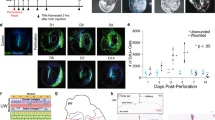Abstract
Epidermal Growth Factor (EGF) has been identified as playing a critical role in the wound healing process. The objective of this study is to investigate the role that EGF plays in rat tympanic membrane (TM) wound healing using two techniques, microarray and immunohistochemistry. The tympanic membranes of rats were perforated using a sterile needle and sacrificed at time points during 2 weeks following perforation. The normalized signal intensities at the time points for EGF and associated genes are presented. The rat EGF mRNA did not change significantly between time points. Five associated proteins, including heparin-binding EGF-like growth factor were found to be differentially expressed above a two fold threshold at 12 h following perforation. EGF staining was found at low levels in the uninjured TM. Levels of EGF staining increased at 24 h in the basal keratinocyte layer, became diffusely elevated in the specimen at 36 h, before a second peak in staining of the keratinocyte layer at Day 4. The staining of EGF corresponds to its multiple roles in TM wound healing.


Similar content being viewed by others
References
Aharonov A, Pruss RM et al (1978) Epidermal growth factor. relationship between receptor regulation and mitogenesis in 3T3 cells. J Biol Chem 253(11):3970–3977
Bennett NT, Schultz GS (1993a) Growth factors and wound healing: biochemical properties of growth factors and their receptors. Am J Surg 165(6):728–737
Bennett NT, Schultz GS (1993b) Growth factors and wound healing: part II. Role in normal and chronic wound healing. Am J Surg 166(1):74–81
Chauvin K, Bratton C et al (1999) Healing large tympanic membrane perforations using hyaluronic acid, basic fibroblast growth factor, and epidermal growth factor. Otolaryngol Head Neck Surg 121(1):43–47
Chole RA, Kodama K (1989) Comparative histology of the tympanic membrane and its relationship to cholesteatoma. Ann Otol Rhinol Laryngol 98(10):761–766
Dvorak DW, Abbas G et al (1995) Repair of chronic tympanic membrane perforations with long-term epidermal growth factor. Laryngoscope 105(12 Pt 1):1300–1304
Edgar R, Domrachev M et al (2002) Gene Expression Omnibus: NCBI gene expression and hybridization array data repository. Nucleic Acids Res 30(1):207–210
Gladstone HB, Jackler RK et al (1995) Tympanic membrane wound healing. An overview. Otolaryngol Clin North Am 28(5):913–932
Guneri EA, Tekin S et al (2003) The effects of hyaluronic acid, epidermal growth factor, and mitomycin in an experimental model of acute traumatic tympanic membrane perforation. Otol Neurotol 24(3):371–376
Hom DB (1995) Growth factors in wound healing. Otolaryngol Clin North Am 28(5):933–953
Lim DJ (1968a) Tympanic membrane. Electron microscopic observation. I: pars tensa. Acta Otolaryngol 66(3):181–198
Lim DJ (1968b) Tympanic membrane. II. Pars flaccida. Acta Otolaryngol 66(6):515–532
Ma Y, Zhao H et al (2002) Topical treatment with growth factors for tympanic membrane perforations: progress towards clinical application. Acta Otolaryngol 122(6):586–599
McGrath MH (1990) Peptide growth factors and wound healing. Clin Plast Surg 17(3):421–432
Mondain M, Ryan A (1995) Epidermal growth factor and basic fibroblast growth factor are induced in guinea-pig tympanic membrane following traumatic perforation. Acta Otolaryngol 115(1):50–54
Nishida T, Nakamura M et al (1990) Differential modes of action of fibronectin and epidermal growth factor on rabbit corneal epithelial migration. J Cell Physiol 145(3):549–554
O’Daniel TG, Petitjean M et al (1990) Epidermal growth factor binding and action on tympanic membranes. Ann Otol Rhinol Laryngol 99(1):80–84
Pfaffl MW (2001) A new mathematical model for relative quantification in real-time RT-PCR. Nucleic Acids Res 29(9):e45
Ramsay HA, Heikkonen EJ et al (1995) Effect of epidermal growth factor on tympanic membranes with chronic perforations: a clinical trial. Otolaryngol Head Neck Surg 113(4):375–379
Rasband WS (1997–2004) ImageJ software. National Institutes of Health, Bethesda, MD, USA. from http://rsb.info.nih.gov/ij/
Rothe MJ, Falanga V (1991) Growth factors and wound healing. Clin Dermatol 9(4):553–559
Santa Maria PL, Redmond SL, Atlas MD, Ghassemifar R (2010) Histology of the healing tympanic membrane following perforations in rats. Laryngoscope 120(10):2061–2070
Schmidt SH, Hellstrom S (1991) Tympanic-membrane structure–new views. A comparative study. ORL J Otorhinolaryngol Relat Spec 53(1):32–36
Schroeder A, Mueller O et al (2006) The RIN: an RNA integrity number for assigning integrity values to RNA measurements. BMC Mol Biol 7(3):3
Tokumaru S, Higashiyama S et al (2000) Ectodomain shedding of epidermal growth factor receptor ligands is required for keratinocyte migration in cutaneous wound healing. J Cell Biol 151(2):209–220
Vandesompele J, De Preter K et al. (2002) Accurate normalization of real-time quantitative RT-PCR data by geometric averaging of multiple internal control genes. Genome Biol 3(7): RESEARCH0034
Acknowledgments
Garnett Passe and Rodney Williams Memorial Foundation for the funding of this study, Assoc Professor Robert Eikelboom for editorial support, Medtronic for sponsorship and supply of microsurgical instruments, and Zeiss for sponsorship of the otomicroscope. The authors acknowledge the facilities, scientific and technical assistance of the Australian Microscopy & Microanalysis Research Facility at the Centre for Microscopy, Characterisation & Analysis, and The University of Western Australia, a facility funded by The University, State and Commonwealth Governments.
Financial disclosure information
The authors do not have any financial interests in companies or other entities that have an interest in the information in the Contribution.
Conflict of interest
None.
Author information
Authors and Affiliations
Corresponding author
Rights and permissions
About this article
Cite this article
Santa Maria, P.L., Redmond, S.L., Atlas, M.D. et al. The role of epidermal growth factor in the healing tympanic membrane following perforation in rats. J Mol Hist 41, 309–314 (2010). https://doi.org/10.1007/s10735-010-9287-1
Received:
Accepted:
Published:
Issue Date:
DOI: https://doi.org/10.1007/s10735-010-9287-1




